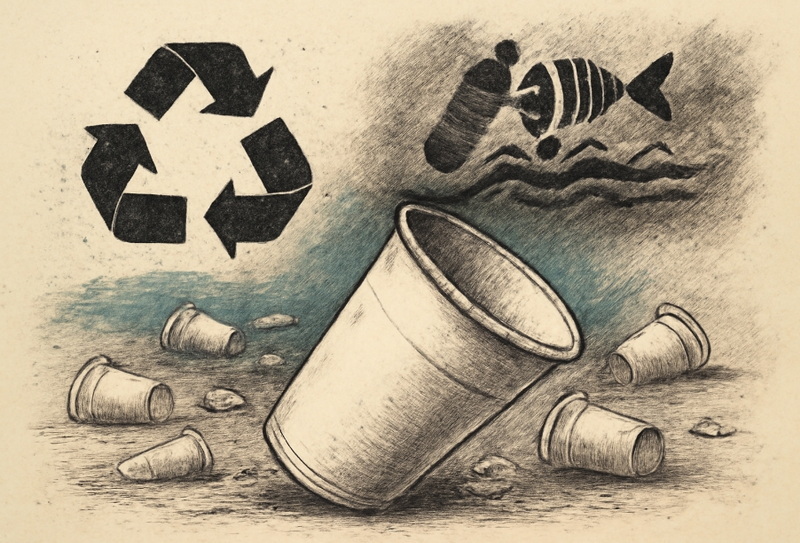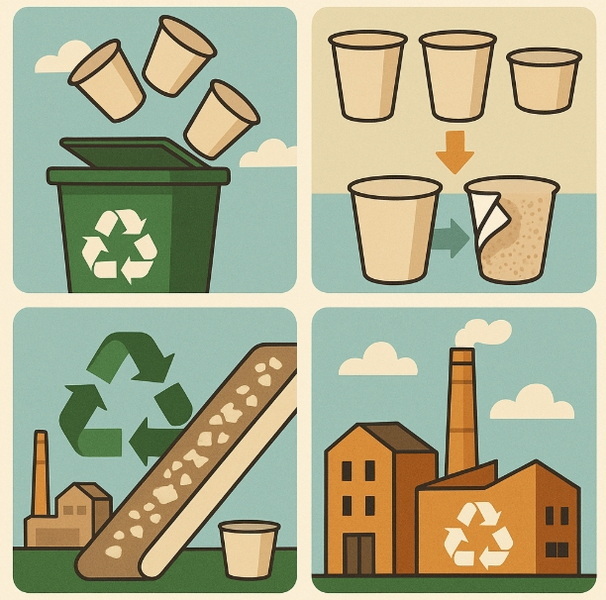
Content Menu
● The Complex Reality of Disposable Cup Waste Recycling
● Recycling Infrastructure and Innovation
>> Limited Facility Access
>> Material Recovery Advancements
● The Role of Consumers and Retailers
>> Behavioral Shifts
>> Retailer Responsibility
● Industry and Policy Initiatives
>> Legislative Measures
>> Corporate Investments
● Environmental Impact of Disposable Cup Waste
● Case Studies of Successful Recycling Programs
>> Seattle's Circular Economy Pilot
>> Berlin's ReCup Initiative
● Challenges in Global Recycling Efforts
● Innovations in Disposable Cup Design
>> Mono-Material Breakthroughs
>> Digital Integration
● The Circular Economy and Disposable Cup Waste
● The Future of Disposable Cup Waste Recycling
● Conclusion
● Frequently Asked Questions
>> 1. Can all disposable cups be recycled?
>> 2. Why is recycling disposable cup waste so challenging?
>> 3. How can consumers help improve recycling rates?
>> 4. Are reusable cups more sustainable than disposable ones?
>> 5. What industries are leading disposable cup recycling efforts?
The global reliance on disposable cups has created a mounting environmental challenge. While these cups offer unparalleled convenience for busy lifestyles, their complex composition-often a mix of paper fibers and plastic linings-makes recycling far from straightforward. This article explores the technical, logistical, and behavioral factors influencing the effectiveness of disposable cup waste recycling, alongside innovations and systemic solutions aiming to address this pressing issue.

The Complex Reality of Disposable Cup Waste Recycling
Disposable cup waste recycling hinges on overcoming material separation challenges. Most paper cups contain a polyethylene (PE) plastic lining to prevent liquid leakage, which complicates traditional recycling processes. Standard paper recycling facilities cannot efficiently separate the plastic from the paper fibers. Specialized mills employ industrial pulpers that agitate cups in warm water, detaching the plastic layer for subsequent processing. However, this method is energy-intensive and requires dedicated infrastructure, limiting its widespread adoption.
Contamination remains a critical barrier. Residual liquids or food scraps degrade paper quality and disrupt recycling machinery. Effective disposal relies on consumer behavior-emptying cups before recycling-and segregated collection systems to prevent cross-contamination with general waste. Without proper preparation, disposable cup waste often ends up in landfills or incinerators.
Recycling Infrastructure and Innovation
Limited Facility Access
Globally, fewer than 50 mills process disposable cup waste. In the UK, only four facilities accept these cups, creating bottlenecks in collection and processing. Expansion efforts focus on retrofitting paper mills and investing in technologies like Georgia-Pacific's Juno system, which recycles cups with minimal preprocessing. However, retrofitting costs and regulatory hurdles slow progress.
Material Recovery Advancements
Innovations aim to simplify plastic-paper separation. Water-based linings and compostable alternatives are emerging, though their viability depends on certification standards. For example, compostable cups require industrial facilities, as home composting leaves non-organic residues. Pilot projects in Scandinavia use enzyme-based treatments to break down linings, achieving 95% fiber recovery rates.
The Role of Consumers and Retailers
Behavioral Shifts
Consumers play a pivotal role in ensuring cups reach recycling streams. Initiatives like in-store drop-off bins and financial incentives for reusable cups encourage participation. A 2024 survey revealed that 68% of consumers forget reusable options when rushed, highlighting the need for habit-forming systems.
Retailer Responsibility
Major coffee chains like Starbucks and Costa Coffee partner with recycling schemes to install dedicated collection points. These programs emphasize education, clarifying that cups must be empty and unlidded. Retailers also advocate for policy changes, such as Scotland's 25p disposable cup levy, which reduced single-use cup consumption by 32% in its first year.
Industry and Policy Initiatives
Legislative Measures
The EU's Single-Use Plastics Directive mandates that 90% of beverage cups be collected for recycling by 2030. In Asia, South Korea's "Cup Waste Deposit System" requires consumers to pay a refundable deposit, boosting return rates to 74%. Conversely, lax regulations in developing nations exacerbate landfill overcrowding.
Corporate Investments
The paper industry has committed $7 billion to recycling infrastructure by 2025. Partnerships between manufacturers like Huhtamaki and waste contractors like Veolia aim to standardize collection protocols. Recent breakthroughs include "smart bins" with AI sensors that reject contaminated cups in real time.
Environmental Impact of Disposable Cup Waste
The lifecycle of disposable cups consumes 20 million trees and 12 billion gallons of water annually. Plastic linings contribute to microplastic pollution, with an estimated 4.7 billion cups entering oceans yearly. Recycling could reduce carbon emissions by 40%, but only 12% of cups are currently processed correctly.

Case Studies of Successful Recycling Programs
Seattle's Circular Economy Pilot
Seattle's 2023 program linked 200 coffee shops to a centralized recycling hub. Customers received a 10-cent discount for returning cups, achieving a 58% return rate. Recycled fibers were repurposed into packaging, diverting 12 tons of waste monthly.
Berlin's ReCup Initiative
Berlin's reusable cup network reduced disposable cup waste by 89% in two years. Users pay a €1 deposit via a mobile app, with 500+ drop-off points citywide. The system saves 3,000 metric tons of CO₂ annually.
Challenges in Global Recycling Efforts
Developing nations face infrastructure gaps-only 8% of India's urban centers have cup-specific recycling. In contrast, Japan's meticulous waste sorting protocols achieve 85% recovery rates but struggle with cross-border waste trade bans.
Innovations in Disposable Cup Design
Mono-Material Breakthroughs
Companies like CupClub produce cups with cellulose-based linings, enabling single-stream recycling. Trials in London show a 90% recovery rate, with fibers reused in 7 cycles.
Digital Integration
Startups like Muuse embed QR codes in cups, offering loyalty points for returns. Sensors track cup locations, optimizing collection routes and reducing transportation emissions by 30%.
The Circular Economy and Disposable Cup Waste
A circular model prioritizes design-for-recycling and closed-loop systems. For example, Dutch firm PaperWise upcycles cup fibers into stationery, while Loop Industries converts plastic linings into polyester yarn. These initiatives require cross-industry collaboration-retailers, manufacturers, and cities must align incentives.
The Future of Disposable Cup Waste Recycling
By 2030, biodegradable coatings and robotic sorting systems could make 90% of cups recyclable. However, scaling requires $20 billion in global infrastructure investments. Behavioral nudges, like default reusable options in apps, may cut single-use demand by 50%.
Conclusion
Disposable cup waste recycling is technically feasible but hamstrung by fragmented infrastructure, contamination, and inconsistent policies. While innovations in material science and digital tracking offer promise, systemic change demands coordinated action. Prioritizing standardized collection, expanding specialized facilities, and incentivizing reuse will determine whether disposable cup waste transitions from an environmental liability to a circular economy success.

Frequently Asked Questions
1. Can all disposable cups be recycled?
Most paper cups with plastic linings require specialized recycling facilities. Compostable cups need industrial composting, while wax-coated cups often cannot be recycled.
2. Why is recycling disposable cup waste so challenging?
Plastic linings must be separated from paper fibers, a process requiring dedicated equipment. Contamination and limited facility access further hinder recycling.
3. How can consumers help improve recycling rates?
Empty cups before disposal, use designated bins, and opt for reusable alternatives. Participating in deposit schemes also boosts recovery rates.
4. Are reusable cups more sustainable than disposable ones?
Reusables must be used 50+ times to offset their carbon footprint. However, they prevent disposable cup waste entirely when adopted consistently.
5. What industries are leading disposable cup recycling efforts?
Paper mills, tech startups, and retailers collaborate on AI-driven sorting systems, chemical recycling, and closed-loop material recovery programs.

















